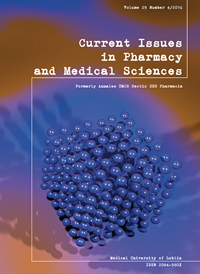Gastric neuroendocrine tumor treated with endoscopic submucosal dissection
DOI:
https://doi.org/10.1515/cipms-2016-0037Keywords:
neuroendocrine tumor, carcinoid, endoscopic submucosal dissection, stomachAbstract
Periodontal disease is an inflammatory disease of multifactorial etiology. In order for it to appear there must come to an imbalance between the effects of pathogens and host defense mechanisms. As a result of its course the destruction of structures supporting the teeth appears (periodontium, cement, bone), and consequently leads to teeth loosening and loss. In recent years, the participation of RANKL/RANK/OPG in bone remodeling process was highligted.At the molecular level the bone resorption is regulated through the interaction of the ligand receptor activator of nuclear NF-kappa B (RANKL) and osteoprotegerin (OPG), which is a system of two proteins belonging to the protein tumor necrosis factor (TNF). Recent findings about the RANKL protein and OPG have shed new light on the previously unexplained phenomenon of the basis of bone resorption. Research has shown that both protein OPG and RANKL can be detected in gingival crevicular fluid, which has become a window of opportunity in the analysis of noninvasive markers of periodontal tissues, confirming elevated levels of RANKL protein in periodontal disease, and decreased levels of OPG protein. Bone resorption is initiated by the binding of the RANKL protein to receptors RANK present on the surface of mature osteoclasts, and their precursors, which leads to the differentiation and activation of osteoclasts. OPG, being RANKL’s inhibitor, has, in turn, opposite characteristics to RANKL, resulting in the reduction of osteoclastogenesis process. Despite all this, the exact mechanism of bone resorption has not yet been elucidated.
References
1. Bosman F.T., Carneiro, R., Hruban H., Theise N.D., editors (2010), WHO Classification of Tumours of the Digestive System 4th ed., Lyon: The International Agency for Research on Cancer.
2. Cai Y.C. et al.: Cytokeratin 7 and 20 and thyroid transcription factor 1 can help distinguish pulmonary from gastrointestinal carcinoid and pancreatic endocrine tumors. Hum.Pathol., 32, 10, 2001.
3. Erim T., Colak Y., Szomstein S.: Gastric carcinoid tumor after laparoscopic sleeve gastrectomy., Surgery for Obesity and Related Diseases, Volume 11, Issue 6, 2015.
4. Jianu C.S. et al.: Gastric carcinoids after long-term use of a proton pump inhibitor. Aliment.Pharmacol. Ther., 36, 7, 2012.
5. Kidd M., Gustafsson B., Modlin I.M.: Gastric carcinoids (neuroendocrine neoplasms). Gastroenterol.Clin. North. Am., 42, 2, 2013.
6. Kwon Y.H. et al.: Long-term follow up of endoscopic resection for type 3 gastric NET. World J.Gastroenterol., 19, 46, 2013.
7. Modlin I.M. et al.: Current status of gastrointestinal carcinoids. Gastroenterology. 128, 6, 2015.
8. Muehldorfer SM et al.: Multicenter Study Group “Gastric Polyps”. Diagnostic accuracy of forceps biopsy versus polypectomy for gastric polyps: a prospective multicentre study. Gut, 50, 4, 2002.
9. Park S.Y. et al.: Expression of cytokeratins 7 and 20 in primary carcinomas of the stomach and colorectum and their value in the differential diagnosis of metastatic carcinomas to the ovary. Hum. Pathol., 33, 11, 2002.
10. Perryman S., Kaltenbach T., Eisenberg D.: Preoperative finding of gastric neuroendocrine tumor (gastric carcinoid) in a patient evaluated for bariatric surgery. Surgery for Obesity and Related Diseases, 7, 5, 2011.
11. Ramage J.K. et al.: UK and Ireland Neuroendocrine Tumour Society. Guidelines for the management of gastroenteropancreatic neuroendocrine (including carcinoid) tumours (NETs). Gut, 61, 1, 2012.
12. Wang Z. et al.: Retrospective analysis of the clinicopathological characteristics of gastrointestinal neuroendocrine neoplasms. Exp. Ther. Med., 10, 3, 2015.
13. Xu T.M. et al.: Clinicopathological features of primary gastric neuroendocrine neoplasms: A single-center analysis. J. Dig. Dis., 17, 3, 2016.
Downloads
Published
Issue
Section
License
Copyright (c) 2017 Authors

This work is licensed under a Creative Commons Attribution-NonCommercial-NoDerivatives 3.0 Unported License.


